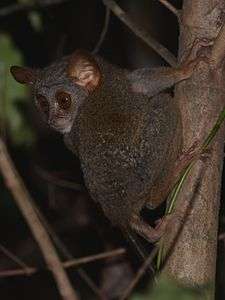Siau Island tarsier
| Siau Island tarsier | |
|---|---|
 | |
| Scientific classification | |
| Kingdom: | Animalia |
| Phylum: | Chordata |
| Class: | Mammalia |
| Order: | Primates |
| Family: | Tarsiidae |
| Genus: | Tarsius |
| Species: | T. tumpara |
| Binomial name | |
| Tarsius tumpara Shekelle, Groves, Merker, J. Supriatna. (2008) | |
Siau Island tarsier (Tarsius tumpara) is a species of tarsier from the tiny volcanic island of Siau.[2]
Its existence as a distinct taxon was predicted by the hybrid biogeographic hypothesis for Sulawesi.[3] The rationale was that a geographic discontinuity existed between the northern tip of Sulawesi, and the population of tarsiers on Sangihe Island (the Sangihe tarsier Tarsius sangirensis), approximately 200 kilometres (120 mi) to the north.[3] In between, lay very deep oceans and three island clusters, Biaro, Tagulandang/Ruang, and Siau. Like Sangihe Island, itself, each of these three island clusters are a part of the Sangihe Island volcanic arc. Volcanic arcs, like the Galapagos and Hawaiian Island chains, feature islands that erupt from the ocean floor. In such circumstances, islands form independently, are colonized independently, and remain geographically isolated. These characteristics lead to high levels of endemism. The presence of tarsiers on the most distant island group in the Sangihe volcanic arc (i.e. Sangihe island), led to curiosity about the presence of tarsiers on the other islands in the chain. Each of the three island clusters mentioned above were surveyed for the presence of tarsiers in 2004 and 2005, but tarsiers were only observed on Siau.
It was furthermore elaborated upon that the original description of T. sangirensis included mention of a specimen from Siau in the Dresden Museum. Thus it was argued for further investigations of the Siau tarsier to see if it was taxonomically separable from T. sangirensis.[4]
The Sangihe Islands are known for their critically endangered avifauna, and concerns about the conservation status of the Siau Island tarsier grew before its formal description.[5]
The Siau Island tarsier was selected for the list of "The World's 25 Most Endangered Primates" by the IUCN Species Survival Commission, Primate Specialist Group.[6]
References
- ↑ Shekelle, M. & Salim, A. (2011). "Tarsius tumpara". IUCN Red List of Threatened Species. Version 2011.2. International Union for Conservation of Nature. Retrieved 18 January 2012.
- ↑ Shekelle, M.; Groves, C.; Merker, S.; Supriatna, J. (2008). "Tarsius tumpara: A new tarsier species from Siau Island, North Sulawesi" (PDF). Primate Conservation. 23: 55–64. doi:10.1896/052.023.0106.
- 1 2 Shekelle, M.; Leksono, S. M. (2004). "Rencana konservasi di Pulau Sulawesi: dengan menggunakan Tarsius sebagai flagship spesies (Conservation strategy in Sulawesi Island using Tarsius as flagship species)". Biota. 9 (1): 1–10.
- ↑ Brandon-Jones, D.; Eudey, A. A.; Geissmann, T.; Groves, C. P.; Melnick, D. J.; Morales, J. C.; Shekelle, M.; Stewart, C. -B. (2004). "Asian primate classification". International Journal of Primatology. 25: 97. doi:10.1023/B:IJOP.0000014647.18720.32.
- ↑ Shekelle, Myron; Meier, Rudolf; Indrawan, Mochamad; Maryanto, Ibnu; Salim, Agus; Supriatna, Jatna; Andayani, Noviar (2007). "When "Not Extinct" is Not Good News: Conservation in the Sangihe Islands". Conservation Biology. 21 (1): 4–5. doi:10.1111/j.1523-1739.2006.00622_1.x. PMID 17298499.
- ↑ Mittermeier, R.A.; Wallis, J.; Rylands, A.B.; Ganzhorn, J.U.; Oates, J.F.; Williamson, E.A.; Palacios, E.; Heymann, E.W.; Kierulff, M.C.M.; Long Yongcheng; Supriatna, J.; Roos, C.; Walker, S.; Cortés-Ortiz, L.; Schwitzer, C., eds. (2009). "Primates in Peril: The World's 25 Most Endangered Primates 2008–2010" (PDF). Illustrated by S.D. Nash. Arlington, VA.: IUCN/SSC Primate Specialist Group (PSG), International Primatological Society (IPS), and Conservation International (CI): 1–92. ISBN 978-1-934151-34-1. Archived from the original (PDF) on July 23, 2011.
Further reading
- Shekelle, M.; Salim, A. (2009). "An acute conservation threat to two tarsier species in the Sangihe Island chain, North Sulawesi, Indonesia". Oryx. 43 (3): 419–426. doi:10.1017/S0030605309000337.
